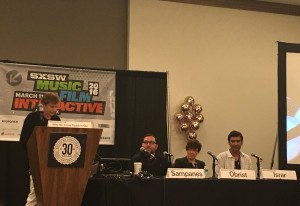Have you ever rejected technology? Whether it be to choose a paper book or printed Polaroid over a digital book or photo. Whatever the reason, the panelists during this talk believe that humans are revolting from tech because they crave touch experiences. We have a need to feel objects vs interacting on a glass screen.
 Marianna Obrist, Reader (Multisensory Experiences) at the School of Engineering and Informatics – The University of Sussex, goes into depth about touch in this panel. The sense of touch has a deep impact on human behavior. The first is that touch informs. She explains when you touch something, you are assessing its intrinsic and physical value. The second is that touch excites. Your sense of touch is attached to your emotions and can impact how you feel. Physical traits and texture affects how you feel about the object. The third is that touch humanizes. It creates confidence, familiarity, and its personal.
Marianna Obrist, Reader (Multisensory Experiences) at the School of Engineering and Informatics – The University of Sussex, goes into depth about touch in this panel. The sense of touch has a deep impact on human behavior. The first is that touch informs. She explains when you touch something, you are assessing its intrinsic and physical value. The second is that touch excites. Your sense of touch is attached to your emotions and can impact how you feel. Physical traits and texture affects how you feel about the object. The third is that touch humanizes. It creates confidence, familiarity, and its personal.
“When you think about touch and how you experience it, you can’t switch it off. You can differentiate between hot and cold, soft and hard. But how do we bring that into technology?” Obrist said. “How do we describe touch? It’s hard to describe. When you say let’s make it softer, how soft is soft?”
“It’s a limiting experience when you think about what your trying to create like visual and audio where most people start. Think about touch, bring touch in the design. People are struggling on how to utilize touch in the design process,” Chad Sampanes, Director/UX Research at Immersion, said. “When you modify those elements, you can create things that are valuable. You need to approach the touch element in your design.”
When Susan Hassler, Editor-In-Chief of IEEE Specturm talks about the challenges with touch, she says “touch is harder to capture than vision is. There’s not a rich tradition on technology touch research to call upon.”
Mid-Air technology has been something Obrist has been working on. By using ultrasound, this technology enables users to feel without touching. “It’s like when you stick your hand out the window and you feel like air push on your hand. This technology is only pressured air, but it feels real,” Obrist said.
“Technology is evolving rapidly, thats for sure. It will be even better not long from now. Instead of approaching touch and asking ‘what technology do I have to apply to some touch element I’m designing’ look at what your trying to accomplish first. What are you trying to bring in the experience that you cant accomplish with visual or audio. What technology do I have available to create that expereince?” Sampanes said.
